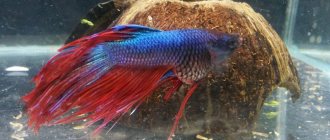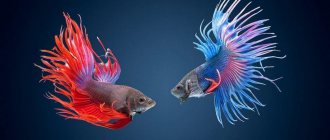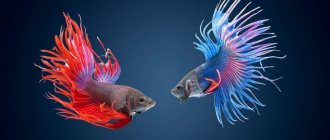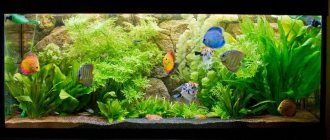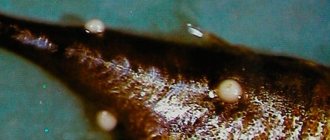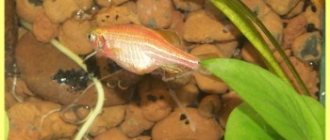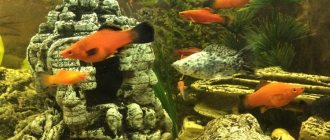Causes of apathetic state
If the cockerel is lying on the bottom of the aquarium, you need to establish the exact cause of the apathetic state.
- The fish was stressed due to moving to a new habitat. After a short period of acclimatization, everything will return to normal.
- This inhabitant of aquatic spaces falls into a comatose state if the water temperature drops below +19°.
- The pet was poisoned with chemicals. Work involving the use of toxic substances must not be carried out in the room where the tank is located.
- Separate stay of individuals of the opposite sex for a long period of time threatens with cystic changes in the gonads . The tumor containing liquid inclusions greatly enlarges the fish belly. Timely created conditions for spawning will help avoid problems.
Smoking near a container with fish is strictly prohibited. Nicotine compounds absorb oxygen. For a cockerel, with its labyrinthine system, breathing is a death sentence.
Reasons for staying on the surface of the water for a long time
Cockerel near the surface of the aquarium.
The cockerel stays on the surface for a long time or makes attempts to jump out of the water in case of high chlorine concentration. Carbon filtration or heating the liquid to 90° will rid it of harmful compounds.
Overeating causes an enlargement of the swim bladder. The betta pushes the fish to the surface; it simply cannot sink to the bottom. A few days of hunger strike will help cope with the situation.
The inhabitants of the aquarium feel oxygen starvation. Discomfort occurs due to low levels of aeration.
Fry and fish individuals that have not reached sexual maturity have a greater predisposition to diseases, stress and depression than adult betas.
Why do they die
- The most natural cause of death is old age.
- Severe stress caused by sudden changes in the chemical composition and parameters of water. This includes a complete, rather than partial, water change, in which the cockerel finds itself in a completely new environment. Too low temperatures also lead to death.
- Toxins and poisons in water - nitrites, nitrates, nitrogenous bases, ammonium, ammonia. Poisoning with nitrogenous bases is determined by a persistent smell of rotting emanating from the water and cloudiness.
- If an inhabitant is placed in tap water, she may die from a gas embolism.
- Unnoticed and untreated diseases such as ichthyophthyriosis, dropsy, oodiniosis, and costiosis lead to death.
What to do if you find dead fish in an aquarium:
- Remove the dead inhabitant from the aquarium.
- Check other representatives for signs of illness and all pets must undergo quarantine.
- Examine the dead pet, check the condition of the abdomen, fins, eyes, gills, after putting on gloves, because many diseases of underwater inhabitants are transmitted to humans.
- If inflammation or rotting of any parts of the body were detected, then check other inhabitants for the same symptoms and select the appropriate treatment.
- Check water parameters.
Diseases characteristic of this type of fish
Uncharacteristic behavior of a pet may be a sign of illness caused by the introduction of a pathogenic agent into the body.
| Diseases | Symptoms | Treatment |
| Ichthyophthiriasis | Spots on the body, stuck together fins, apathy. | Changing water, using special salts, conditioners, copper |
| Dropsy | Swollen abdomen, ruffled scales. | Change the water daily for a week, add a drug with the active ingredient nifurpirinol |
| Fin rot | A white coating with a bluish tint appears on the tail and fins. The next stage is the complete decomposition of the rays of the fins and tail. | Use of long-acting antibacterial agents |
| Saprolegniosis | Damage to fin rays, scales, skin, gills. | Polyene antibiotics: nystatin, chloramphenicol |
| Gill fluke | The cockerel fish lies on the bottom of the aquarium and breathes heavily. The gills are faded, covered with mucus, and sometimes foreign aggressors are visible on them. | Antihelminthics |
| Oodiniosis | Golden-reddish coating on the scales, frequent short breaths, tightly compressed tail rays, peeling of the skin. | Antibacterial and antifungal drugs |
| Exophthalmia | Protruding eyes that have come out of their sockets, cloudy or covered with a white film. | Change the water in the tank after treating it with Epsom salt. Monitor fluid temperature daily |
Sick fish should be removed from the common container to avoid infection of other inhabitants. Treatment with antibacterial substances is recommended to be carried out in a special sedimentation tank without adding soil and plant flora.
Common problems
Symptoms of the disease are associated with deterioration in appearance, impaired visual and olfactory functions, problems with the gastrointestinal tract, impaired motor functions and the respiratory system.
- If symptoms appear in all inhabitants at the same time, then the problem is usually in the environment: poor quality water, lack of oxygen in the water, low temperature, nitrates.
- If the problem affects only one species and not the other, then infectious diseases develop in the aquarium.
- If one inhabitant is sick, then there are problems with physical, mental illnesses, old age, injuries.
Conduct a thorough examination of the sick, check the water parameters and move the sick representatives to a quarantine tank.
Lies at the bottom
The most common symptom of the disease is the betta fish lying on the bottom.
- Old age.
- Cool water reduces the activity of tropical fish, which is why they fall into a lethargic state: they stop responding to food, stay in one place, and the betta lies on the bottom and breathes heavily. The low acceptable threshold for tropical inhabitants is considered to be a water temperature of 19–20 degrees.
- If a pet is breathing heavily and lying on the bottom after moving, moving to another, unusual environment, a new aquarium, to other inhabitants, then this is completely normal. The cockerel is just stressed. After acclimatization, the betta will become active again after some time.
- But the symptom, when the inhabitant is breathing heavily while lying on the bottom, has more dangerous causes. One of them is chemical poisoning of the body. Check water indicators using tests, move the inhabitants to a favorable environment.
- Dropsy is a bloated body.
- Fin rot is a white coating on the fins, their rotting.
- Ichthyophthiriasis - white spots on the skin.
- Oodiniosis is a red coating and spots on the skin.
- Gill fluke - gills are covered with mucus, parasites are visible.
- Exophthalmia - bulging eyes.
- Saprolegniosis is a white fluffy coating on the head, body, tail, similar to mold spores. Treatment with baths with salt and malachite green, antibiotics.
The course of treatment depends on the disease causing the symptom. For prevention, feed the betta fish 2 times a day in small portions, replace the water, disinfect the new soil, and do not overpopulate the aquarium.
Doesn't eat
Lack of appetite is not always caused by illness. Safe reasons include the cockerel not accepting one type of food (more often this happens with dry food). In this case, try replacing regular food with live food: brine shrimp, bloodworms, pieces of lean fish, squid. Another such reason is food particles that are too large in size, which he is unable to swallow.
Elimination of harmful factors
Although bettas do not need aeration, having a filter in the aquarium will greatly improve your pet's living conditions.
Like any living creature, a fish needs good care. High-quality filtration of water in the tank is the basis for the well-being of the inhabitants. The filter is installed to exclude stagnant zones. The quality of the equipment is checked and cleaned periodically. The filter cannot be washed until it is completely sterile . Beneficial microorganisms must remain in it to maintain biological balance.
When filling the aquarium, leave free space between the lid and the surface of the water. The cockerel breathes atmospheric air. If it is impossible to saturate the body with oxygen from the surface of the water, the fish will constantly lie on the bottom until it suffocates.
Keeping two or more adult males of this species in a home ecosystem is fraught with danger. In fights they can cause irreparable harm to each other. Females are friendly with each other, which cannot be said about the attitude of individuals of the opposite sex towards them. Cockerels do not get along well with sedentary relatives. They like hyperactive, nimble neighbors.
When decorating a tank, do not forget: natural flora is a natural filter that promotes the penetration of oxygen into the bottom water layers.
Cockerel fish, I’m sharing my experience, maybe it will be useful to someone
Good afternoon, advisors. Lots of letters! And this topic will be of interest only to those who are planning to purchase such a pet. About six months ago I became interested in this type of fish and kept one of them. Let me clarify right away that I do not pretend to be an expert in maintenance and care, but I am sharing practical advice that I received on specialized forums and after reading a lot of articles about these fish. What prompted me to write this opus was a picture I saw more than once in pet stores, where I often visit. Mom and child buy a cockerel, 1.5 liters for it. a round vase, and the seller “rubs in” that the fish is so unpretentious that it can almost live without water. Mom listens with her mouth open and nods. And I look at this fish, already packed in a bag. and it becomes so sad. ((((So, you decided (with absolutely no knowledge and experience in aquarium keeping) to get fish. What is good about a cockerel? 1) A very beautiful and unpretentious fish. It has a curious disposition and interesting behavior. Does not require company. 2) Does not require large volumes in content. Due to the fact that in nature it lives in puddles of rice fields, some claim that it can be kept in almost a 0.5 liter glass, but this is not entirely true! Having sifted through many forums, articles and observed emotional discussions among fans of this fish, I came to an unambiguous conclusion: 1 male fish will feel great in a 5-10 liter aquarium. It is in such volumes that the generally lazy and quickly tired male fish will delight you with active swimming. In large communal aquariums, he often gets lost and “hangs” somewhere in a corner or hides.
3) Labyrinth fish; in labyrinth fish, blood saturation with oxygen occurs when air is swallowed through the mouth. Those. it doesn’t need a compressor (the thing that releases air bubbles into the aquarium)! But only if the fish is healthy! For various diseases, experts still recommend saturating the water with oxygen during the treatment period.
And now in more detail. Beautiful long-tailed cockerels in pet stores are sold already grown and are at least 6 months old. In good conditions they live 2-2.5 years. very rarely even before 3 years. When choosing a fish, pay attention to the integrity of the fins and the absence of wounds, plaque, etc. You should not buy apathetic, as if frozen fish.
Aquarium about 5l. preferably not round (round ones are inconvenient to care for and it’s problematic to attach special equipment), but rectangular or square. Bettas can (and often do) jump out, so a cover slip is a must. No compressor required, filter optional. I have a mechanical cleaning going on; it won’t be superfluous. Cockerels do not like currents and prefer standing water, so the “exhaust” is directed towards the glass. or even better, install a “sprinkler”. I spent a long time choosing a filter and settled on the Chinese SunSun HJ-111B, it is inexpensive (up to 100 UAH) and almost silent, it comes with a sprinkler and a device for saturating the water with oxygen (it won’t be superfluous, you don’t have to use it). Ideal for 5-10L aquariums. In the autumn-winter period, you definitely need a thermostat (heating pad), since this is a tropical fish, and at temperatures below 22-24 it can feel unwell, get sick, and die. The smallest one I found is aHeater mini from our Chernigov company collar. Supports t. within a +25 radius. The filter and heating pad (heating pad in cold weather) must work constantly.
A set of preventive measures
Proper living conditions will help avoid long, labor-intensive rehabilitation of the aquarium inhabitant. Recommendations:
Don't overfeed your pets!
- feed your pet 2 times a day with a portion that he can absorb in 2 minutes;
- diversify your diet, use live food;
- do not move the tank;
- remove food residues from the ground in a timely manner;
- change the water regularly;
- maintain the hardness and acidity of the liquid within optimal limits;
- Before placing soil and plants in the ecosystem, treat them with disinfectants;
In order not to end up with a bunch of problems and not to put other pets at risk of infection, carefully inspect the fish when purchasing. Often individuals become infected during transportation.
Do not place a new resident in a community aquarium without quarantine. The more suspicious the source of acquisition is, the longer the period of isolation. Until you are completely sure of the reliable condition of the fish.
How to properly set up a new aquarium
Often, beginning aquarists think that it is enough to fill the aquarium with water, turn on the equipment, and the fish’s home is ready. This is irresponsible behavior and can kill any fish, including bettas. It will take time to arrange a habitat for pets: a biosphere must form.
Do not allow chemicals to get into the water under any circumstances. You should also check its composition with special testers. It is recommended to fill in fresh liquid in a volume not exceeding 20% of the total. Check and maintain a comfortable temperature - about 26 degrees. Do not expose inhabitants to sudden changes in environment. Any deviations will lead to illness.
Prevention
Many pathogens of dangerous diseases constantly come into contact with fish, live in the same environment and do not manifest themselves without reason. Therefore, treatment of betta fish diseases will not be necessary if they are prevented through prophylaxis.
- Keeping the aquarium clean is considered the best preventive measure against all diseases. In a contaminated tank, pathogenic bacteria and viruses actively multiply.
- Knowledge of optimal conditions for keeping cockerels. They have boundaries in their care, outside of which they feel unwell and get sick. This especially applies to water temperature, to the readings of which bettas are especially sensitive: sudden changes cause stress in fish and reduce immunity.
- Water parameters, acidity, gases, hardness, and chemical indicators greatly affect the well-being and health of fish. The aquarist must monitor these parameters and keep them within acceptable limits.
- Quarantine is required for all purchased fish. New inhabitants cannot be introduced into the aquarium until the month-long quarantine is over. And only after you are convinced of the health of the fish, it is released to other inhabitants.
- Disinfection of new decorative elements, soil, and artificial plants is mandatory.
Diseases of fighting fish are difficult to recognize without the experience and knowledge of a veterinarian, but based on the symptoms, even a novice aquarist can recognize the disease and promptly help the pet. But it’s better not to get sick at all, maintaining the required balance and cleanliness in the aquarium.
When being at the bottom is normal
Sometimes strange behavior is a manifestation of the fish’s natural instincts. Therefore, do not rush to worry if the cockerel lies on the bottom - perhaps this is his natural behavior. These fish live in ponds with stagnant water, so sometimes they are more comfortable at the bottom of the aquarium, where they will not be carried away by the current.
Although there is no water flow in the tank, the fish obeys its instincts. Bettas also like to lean on resting objects and rest. Or they may just doze off. At the bottom, the pet gets acquainted with the new environment and adapts to the new home. In addition, here he is not disturbed by other inhabitants of the aquarium. If you just stocked your betta, he will stay on the bottom for a while. Wait 2-3 days - the fish will get used to its new home and begin to behave as usual.
Diseases and treatment
Fin rot
Pseudomonosis is especially painful in cockerels, because their fluttering, lush fins become peeling and rotting. If left untreated, it completely eats away the skin of the fin, leaving only the fin rays.
Causes: The bacteria that cause fin rot are constantly present in the aquarium and do not cause harm if there is no reason for the sudden development. These include:
- Soil contamination with waste and food.
- High reservoir population density.
- Violation of the chemical characteristics of water or biobalance.
- Infections acquired by new inhabitants.
- Poor water filtration.
- Lack of aquarium cleaning.
Symptoms: fading of the bright color of the cockerel, fins stick together, the skin puffs up and peels, the cornea of the eye is cloudy, ulcers form at the roots of the fins, holes appear, the skin of the fins decomposes, only rays remain.
Treatment: medications to combat bacterial and fungal diseases. Baths with table salt, malachite green, and bicillin also help. Specialized preparations have been developed to combat fin rot.
Prevention: maintaining cleanliness and timely cleaning of the soil, having a powerful filter.
Dropsy
A dangerous disease in fish that is classified as bacterial, but it is also caused by parasites. Dropsy is characterized by swelling of individual parts of the body or the entire body. But dropsy is usually considered a symptom for more serious diseases. The most common: mycobacteriosis, aeromonosis, hexamitosis.
The disease does not affect all representatives at the same time - in fish with strong immunity, dropsy may not develop at all. Young animals suffer more often. The first place that dropsy affects is the intestines, because bacteria and parasites enter the digestive organs through the mouth. The excrement takes on an unhealthy color and becomes covered with mucus. Fish are not able to fully digest food, but sometimes still continue to eat it. Gradually other internal organs are affected. When the disease reaches the kidneys and they do not perform their work, a characteristic sign of dropsy appears - the body swells with internal fluid, causing bulging eyes and raising of the scales.
Reasons: bacteria, parasites, kidney problems, long-term stress, sudden and frequent temperature changes, low-quality food, mainly from the meat of warm-blooded animals.
Symptoms: swelling of the abdominal cavity, bulging eyes, mucus in the excrement, white mucous pieces of intestine protruding from the anus.
Treatment: medications and food depending on the cause of the disease.
Prevention: keeping the aquarium clean, maintaining immunity, varied diet.
Bulging eyes (exophthalmia)
Aquarists classify exophthalmia or bulging eyes both as a separate, isolated disease, and as one of the symptoms of more serious diseases. More often caused by parasitic inhabitants of the body, infection. It usually appears together with dropsy - the accumulation of fluid in the insides of the fish.
During exophthalmia, fluid accumulates behind the eyeball and gradually penetrates into the eye itself. Either one or both eyes may be affected.
Causes: bacterial diseases, infection, fungal diseases, insufficient amount of vitamins in food due to a monotonous diet, abnormal physiological processes, viruses, eye flukes. Poor water quality, chemical additives, nitrates, and toxins contribute to the development of the disease.
Symptoms: cloudiness of the membranes of the eyes, one or both eyes bulge, possibly even falling out of the orbits. Appetite worsens, fish activity decreases, cowardice and photophobia appear.
Treatment: establish the causes of the disease: infection, parasites, viruses, bacteria and get rid of the cause of the disease with the help of medications. If the cornea becomes cloudy (which indicates poor-quality water composition), replace part of the water every 2 days.
Dropsy
Dropsy most often begins in bettas with weak immune systems, and can affect fish even in a suitable environment with proper care. The second name of the disease is ascites. Symptoms of dropsy:
- The cockerel's belly suddenly swelled;
- there was a ruffling of bullshit;
- bruising appeared;
- the eye is swollen or both eyes are swollen;
- I lost my appetite.
To cure dropsy, it is necessary to use antibacterial medications for oral use, or antibiotics. Treatment will be effective only at the initial stage. If a large amount of time has passed, and taking the drugs does not give a positive result, the infected individual should be killed and all units should be disinfected.
